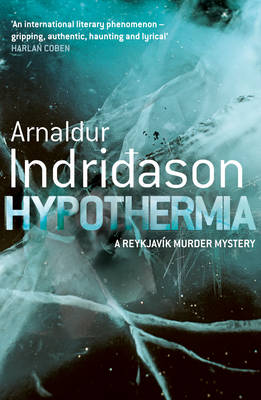
EURO CRIME
Reviews

Indridason, Arnaldur - 'Hypothermia' (translated by Victoria Cribb)
Paperback: 320 pages (Oct. 2009) Publisher: Harvill Secker ISBN: 1846552621
HYPOTHERMIA is among the very best of the books I've read this year. It's the sixth of the author's Erlendur series to be translated into English; it is truly a mature, masterful and utterly fantastic book.
It's a story stripped bare to the bone. A young woman, Maria, commits suicide at her holiday cottage on the shores of Lake Thingvellier. About 30 years ago, Maria's father Magnus fell from his boat and drowned in the same lake. Ever since then, Maria has been extremely close to her mother, Leonora, still living with her even after graduating from university and her marriage to a doctor named Baldvin, who moved in with the two women after his wedding to Maria. Leonora died of cancer two years before the book opens, during which time Maria gave up her job to nurse her mother, constantly at her side. Everyone assumes that part of the reason for Maria's suicide was her inconsolable loss.
Erlendur is only involved in this case tangentially, in that he is told of Maria's death because Maria's main house is in his jurisdiction, so it falls to him to inform Baldvin of her death. Baldvin is devastated. A few days later, however, Maria's friend Karen, who discovered the body, comes to see Erlendur, convinced that Maria cannot have killed herself. Not only was Maria in a positive frame of mind, but Karen has a tape of a recent session between Maria and a medium, in which Maria talked of her comfort in being in touch with her mother from beyond the mother's grave - the two women had talked about this in the mother's final days, and agreed on a method of communication if there is "life after death".
Although Erlendur is sceptical, he is irresistibly drawn to situations involving the missing and the disappeared. He's already looking into three old cases of young people who have suddenly and inexplicably vanished, reflecting on the impact these events have had on the families of the departed. Family members tend to get in touch a on birthdays or anniversaries of the disappearances to find out if there is any news, and Erlendur sees how time takes its toll as the parents of these vanished teenagers become more infirm and eventually die. Erlendur largely lives in his own past, as his own life was shaped by a traumatic event when he was 10 years old. He and his younger brother (aged 8) were out on the hillside in a blizzard, and both boys became lost in the storm. Only Erlendur was found, nearly frozen to death.
Reflecting on these events, Erlendur visits the friends and relations of Maria, the dead young historian. He becomes more interested in the accident in which her father drowned, and digs out the details of the old police investigation, which seemed to have been carried out in a rather perfunctory fashion. At the same time, in a familiar theme in these books, he pursues new leads in the cold cases with characteristic focus.
The events of HYPOTHERMIA occur in a bubble removed from any official criminal investigation - although Erlendur interacts occasionally with his colleagues, the story focuses on his "private" investigation of Maria's death and the old disappearances. Although Erlendur does not believe in the afterlife, he's driven by his own inner need to speak for the lost and the missing, and perhaps above all to seek to thaw out some of the hypothermia of the souls of those who are left behind - including himself.
Erlendur's family life is also a fairly significant part of this book, as his own two children gradually switch roles with Erlendur and his long-ago divorced wife. Eva Lind (mainly) and Sindri want their parents to meet and to reconcile themselves to the break-up of their relationship, but it is quite clear that they are incapable of even the slightest understanding of each other's point of view. Perhaps because of Eva Lind's determination that her parents achieve some closure, or perhaps because of the investigations he's involved in, Erlendur reads to Eva Lind from a book describing the events in which he and his brother were lost, and he reflects on the impact the events, and the book's publication, had on his mother and on his own decisions at the time of his mother's death - directly relevant to Eva herself.
It is hard to convey the sadness and depth of HYPOTHERMIA. The book's plot is completely solid, being an apparently simple tale of a man going round talking to various people, but underneath there are so many layers of the past, of emotion and mood, of different ways of looking at death, disappearance and the lost, descriptions of the ways of life on this bleak island, and how past ways are changing.
There are no dramatics in this story, no exciting set-pieces or thrilling climaxes. The book is simply a rich, thoughtful, mature and compelling work, sympathetically translated. These Icelandic books have much in common with Michael Connelly's Harry Bosch series, in particular the lonely perspectives of the protagonists Harry and Erlendur in speaking for the dead and disappeared of however many years ago - but each is a unique creation. I loved HYPOTHERMIA, with its ageless, deeply sad stories lying beneath its pages.
Maxine Clarke, England
October 2009
Details of the author's other books with links to reviews can be found on the Books page.
More European crime fiction reviews can be found on the Reviews page.